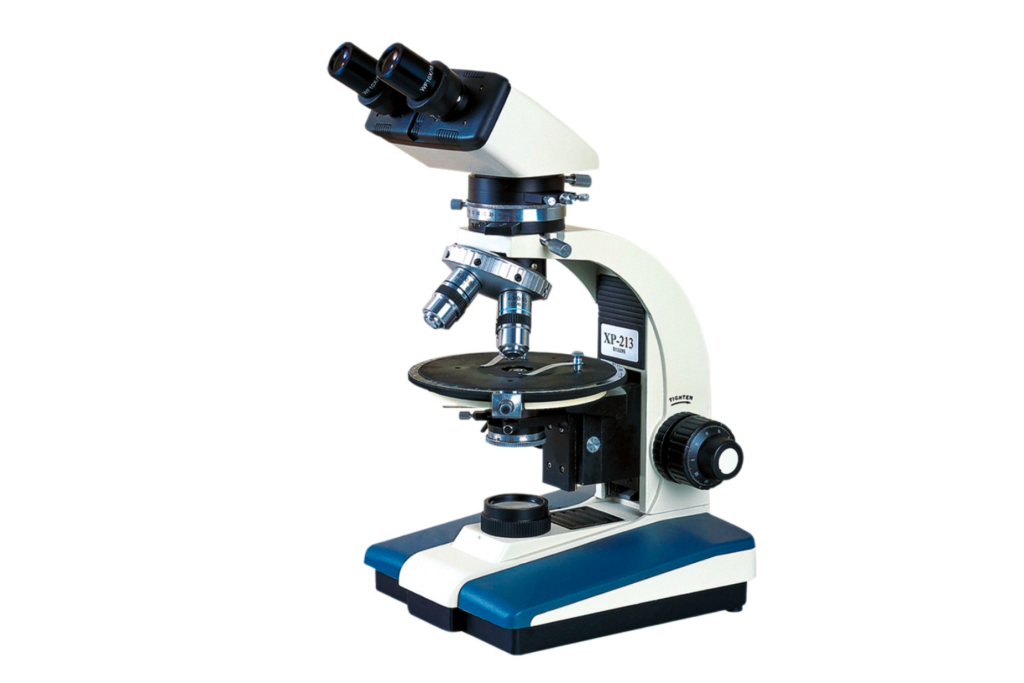I. Definition and Basic Principles of Polarizing Microscope
1 Definition
A polarizing microscope is used to study materials with transparent and opaque anisotropy. Any substance with birefringence can be clearly distinguished under a polarizing microscope. While some of these substances can be observed using staining techniques, others require a polarizing microscope.
The reflected polarizing microscope is an essential instrument for studying and identifying materials with birefringence using the polarization properties of light. It is available for users to conduct single polarized observation, orthogonally polarized observation, and cone light observation.
2 Basic Principles
Malus’s Law: When light passes through a polarizer, it becomes polarized light, with its intensity denoted as Io. After passing through an analyzer, the intensity of transmitted light is given by I=Io*cos^2θ, where θ is the angle between the polarization direction of incident light and the transmission axis of the analyzer. Hence, when the polarizer is perpendicular to the analyzer (at 90°), the intensity of transmitted light is minimal, known as the “dark position.”
Principle: The polarizing microscope employs two polarizing filters perpendicular to each other to obtain the so-called “dark position.” In this position, the field of view is entirely black. If the sample exhibits isotropy optically (isotropic material), the field of view remains dark regardless of the rotation of the stage. This is because the vibration direction of the linearly polarized light formed by the polarizer remains unchanged. According to Malus’s Law, the intensity of transmitted light is 0. If the sample has birefringent properties, the field of view becomes brighter. This is because when linearly polarized light emitted from the polarizer enters the birefringent material, two linearly polarized lights with different vibration directions (o-light and e-light) are generated. When these two lights pass through the analyzer, the e-light, which does not follow the law of refraction, is not perpendicular to the polarization direction of the analyzer, allowing it to pass through. Thus, a bright image can be observed in the field of view.
II. Applications of Polarizing Microscope
The polarizing microscope (also known as a polarizing microscope) is an important technique applied in various fields, including research and quality assurance. It not only generates images at high magnification and resolution, which are typically achieved with a conventional optical microscope, but also provides additional information about sample structure, optical properties, and composition by examining the shape, structure, color, birefringence, and further optical properties of the sample.
Polarizing microscopes have wide applications in quality control across different industries and in earth sciences:
- Earth Sciences: Geology, Petrology, Mineralogy, Crystal Structure Characterization, Asbestos Analysis, and Coal Analysis (for vitrinite reflectance)
- Quality Control: Glass (stress birefringence or inclusions), Plastics and Polymers (stress birefringence), Textiles and Fibers, Electronics Displays, and Liquid Crystal Inspection.
III. Performance of XP-213 Polarizing Microscope

- It is a conventional transmission polarizing microscope for routine testing and teaching.
- They are widely used in crystallography, analytical chemistry, medicine, biological sciences, environmental sciences, pharmaceuticals, toxicology, and other fields.
- Provides clear and sharp images for single polarized, orthogonally polarized, and cone light observations.
IV. Technical Specifications of XP-213 Polarizing Microscope
| Observation system | Flat pull binocular observation head with an inclination angle of 30 ° |
| Flat pull three eye observation head with an inclination angle of 45 ° | |
| eyepiece | WF10X/18 |
| WF10X/18 Cross Eyepiece | |
| Reticle board | |
| Grid board | |
| Objective Lens | Stress free achromatic objective lenses 4X, 10X, 25X, 40X, 63X |
| Lamp room calibration objective lens | |
| Converter | Internal four hole converter with adjustable center |
| Analyzer | 0 ° -90 ° rotary polarizer |
| Bertrand Lens | Bulbous mirror, adjustable center, adjustable focus, and movable optical path |
| Optical Path Compensator | λ Test board (first level red), 1/4 λ Test board, quartz wedge test board |
| Circular Rotating Stage | diameter Φ 160mm, scale value of 1 °, scale value of 6‘ |
| Condenser | NA1.25 Abbe type condenser with variable light bar and filter |
| Focus Adjustment | Coaxial coarse and micro focusing mechanism, focusing range of 26mm, fine adjustment grid value of 0.002mm |
| Polarizer | Can rotate 360 ° |
| Illumination System | 6V/20W halogen lamp with adjustable brightness (for transmission) |
| Accessories | Mechanical moving ruler, movement range: 30X40mm (including slicing test piece holder) |
| Flattening machine | |
| Micrometer ruler | |
| Blue filter |